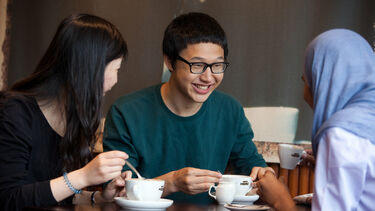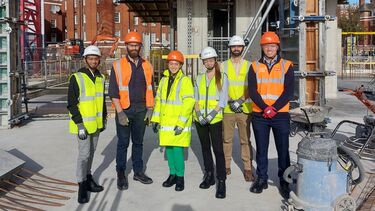Jay gained valuable real-world insights during his structural engineering placement with Arup in London. He worked as a Structural Engineering Industrial Trainee within the Buildings team, working on some interesting projects and gaining real experience working within civil engineering. Jay also spent 3 months of his summer in an earlier year, as a Live-Build volunteer working onsite on a residential project constructing Nest House, a small sustainable modular timber home, built using Studio Barks innovative, sustainable, and low carbon building system (U-build) comprising of only timber and metal.
Tell us about your placement
I worked on 2 amazing projects: Park Tower Hotel in Knightsbridge which required investigating the feasibility of adding an extension onto an existing hotel tower with some scheme design, and La Sagrada Familia in Barcelona where I worked on the scheme and concept design of various parts of this iconic world heritage site. The role involved solving structural analysis problems using Computer Aided Design (CAD), Finite Element Analysis (FEA), and parametric modelling software, and designing structural systems using a variety of materials through hand calculations and modelling.
Working on La Sagrada Familia sounds like an amazing opportunity. Can you give us a bit more detail about the type of work you did at Arup?
I was mainly involved with tasks related to analysis and design on both projects, making finite element analysis models for the hotel structure on PTH and various towers and facades on the Sagrada using Rhino/Grasshopper (CAD software) and GSA (structural analysis software). I also improved my 3D CAD modelling skills when using archived hand drawings to create the PTH Rhino model and make complex beam and slab structures for the already complicated geometry used on the Sagrada Familia.
How did your study help you to do your work?
Some of the calculations I was required to do on my placement were similar to those carried out in our third-year group work so these modules were directly applicable. In addition, the teamwork and communication skills I developed whilst working in groups at university came in handy during my placement as well as the technical, software and problem-solving skills from university courses.
What did you gain from your placement?
Working in the field of civil engineering is split into two main categories contracting or consulting and gaining industrial experience through a placement helped me understand which I would like to pursue in the future. It also helped put the technical knowledge I gained at university to use and to build on this, and helped identify weak points that I needed to work on before taking on a full-time role. Apart from technical skills, my placement allowed me to work in a professional environment and build on useful soft and technical skills too.
Over the course of my placement, I improved key written, verbal and visual communication, interpersonal, presentation and research skills within a professional environment. I enhanced my knowledge and understanding of 3D CAD, geometrical design, parametric modelling, finite element analysis and structural analysis software and broadened my technical knowledge and understanding of a large variety of key structural engineering systems, calculations, and concepts as mentioned above. I also refined my ability to solve structural engineering problems and accurately read and interpret technical structural drawings. I further improved my understanding and interpretation of finite element analysis and structural analysis models and results. Overall, I developed and grew into a better and more complete structural engineer.
What did you enjoy most about your placement year?
I especially enjoyed networking and meeting other engineers both at a similar level and those senior to me, conversing and working together with these engineers taught a variety of skills too. I got the opportunity to work on two great projects, and with La Sagrada Familia being a famous world heritage site, it truly was a once in a lifetime opportunity and being a small part of such a grand project really was the highlight of my placement. Apart from professional side of things, I also enjoyed attending and organising social events and work sports,
What did you gain from your placement and how has this influenced your plans for your future career?
I improved my interpersonal skills and became a more confident engineer which directly translated into the work I did during my final year at university, especially in relation to my final year project. In addition, some of the new software like Rhino/Grasshopper, GSA and Bluebeam that I learnt on placement turned out to be quite useful at university, especially on my final year project.
My placement played a very crucial role in deciding the role I pursued in my future career, firstly it cemented my choice of working in the consultancy sector of the civil engineering industry. In addition, it not only provided me with key professional experience, but I was also lucky enough to have worked in a firm with an amazing work environment, so much so that I have now joined Arup in London as a Graduate Structural Engineer.



